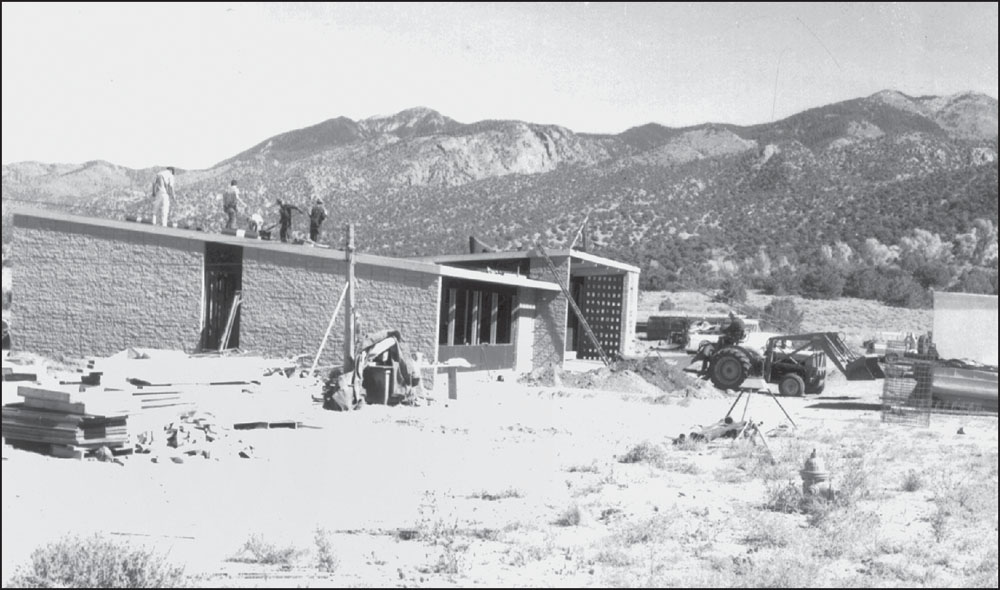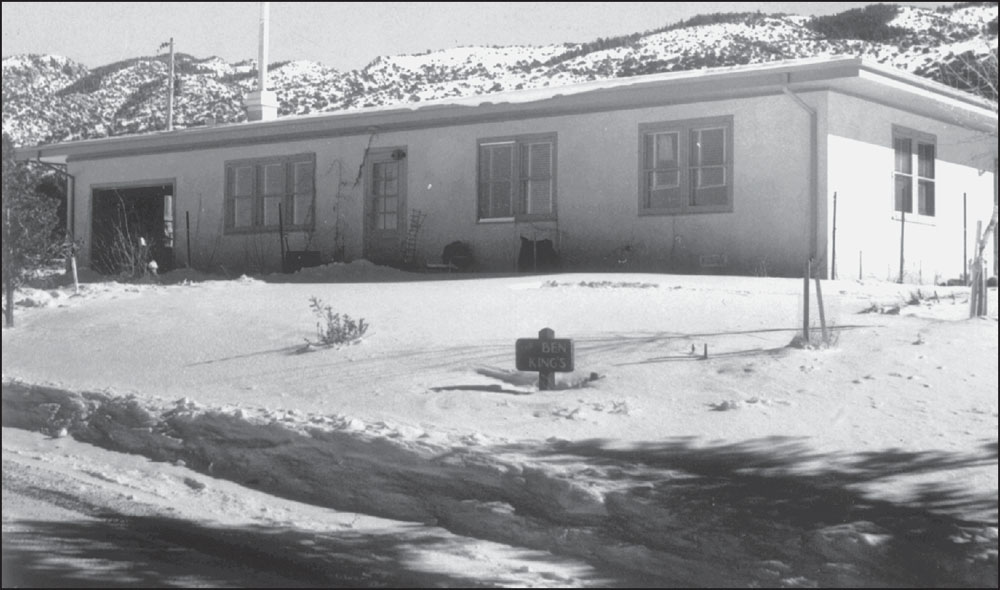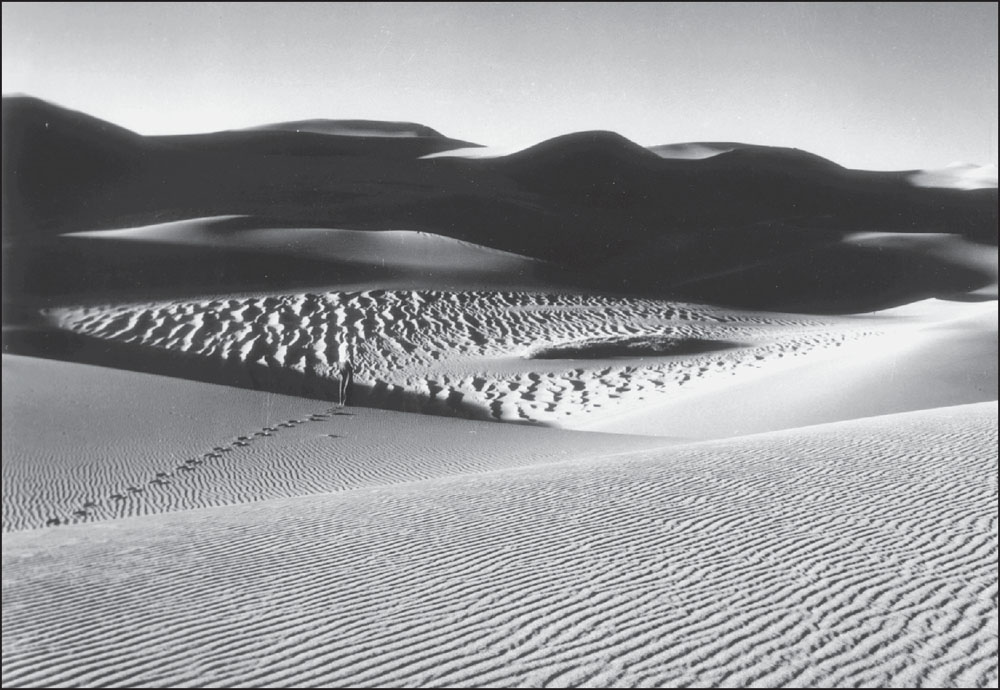Eight
NATIONAL MONUMENT
MODERN YEARS
Visitation at Great Sand Dunes National Monument in 1958 totaled 41,000 guests, quadruple Roger Toll’s 1931 estimate of 10,000. This increase was particularly amazing considering the poor condition of roads to the dunes and the virtual lack of any visitor facilities (other than a few picnic tables). There was no visitor center, no campground, and no amphitheater. Nationwide, the national parks were still operating with dilapidated facilities designed for 17 million visitors in 1940 but were being inundated with 54 million visitors in 1954. Staffing levels from 1940 had not been increased either.
Viewing this situation in 1951, the new director of the National Park Service, Conrad L. Wirth, decided to take a bold step. He saw the advantage of placing the entire national parks want list together in one funding package, rather than going at it piecemeal. He developed a 10-year program, which would begin in 1956 and endeavor to bring every park up to standard by 1966. The program was called Mission 66 in celebration of the 50th anniversary of the National Park Service in 1966, which would also be the year of the building program’s completion. Its budgeted cost was $800 million, but expenses came to $1 billion by the time it was completed.
For Great Sand Dunes, Mission 66 finally brought about the facilities needed by visitors. The entrance road was paved in 1959, and construction of the Visitor Center began in 1961. A maintenance building was also constructed in 1961, followed by Pinyon Flats Campground in 1963 and employee housing in 1964. Finally, in 1966, an amphitheater with seating for 500 people was constructed. The Mission 66 projects were so successful for Great Sand Dunes that visitation again more than quadrupled with 178,000 visitors arriving in 1968.
Great Sand Dunes National Monument was born in the Great Depression, and visitor infrastructure was basically neglected until the Mission 66 program began. Then, with the escalation of the Vietnam War in 1966, funding for the national park system was again curtailed. There would not be another major investment in the dunes until the expansion of the Visitor Center in 1997.

ENTRANCE STATION, JUNE 1958. Great Sand Dunes superintendent Harold Schaafsma (left) greets National Parks Service director Conrad Wirth at the entrance station. Wirth was the creator of the Mission 66 national parks improvement program. (GRSA-2176.)

ENTRANCE ROAD. One of the first projects of Mission 66 in Great Sand Dunes was the paving of the entrance road in 1959. To the right in this image, a snowcapped Mount Herard rises majestically above the dunes. (GRSA.)

VISITOR CENTER CONSTRUCTION, AUGUST 1961. The sweeping curve of the Visitor Center patio is seen here under construction in 1961. The view is looking south toward the San Luis Valley. (GRSA-2191.)

COMPLETED VISITOR CENTER PATIO, AUGUST, 1963. Superintendent Schaafsma (right) chats with three visitors on the patio. (GRSA-2173.)

VISITOR CENTER CONSTRUCTION, OCTOBER 1961. The Visitor Center is well under way in this view looking north to the Sangre de Cristo Mountains. (GRSA-2195.)

VISITOR CENTER ENTRANCE CONSTRUCTION, OCTOBER 1961. This westward view shows the front entrance to the building. The Great Sand Dunes would be directly visible from the patio on the opposite side of the building. (GRSA-2196.)

VISITOR CENTER, C. 1970. Built with basic concrete-block construction, the Visitor Center reflected Mission 66 architecture, quite different from the Spanish-territorial flavor of the superintendent’s residence. (GRSA.)

VISITOR CENTER, AUTUMN 1970. Autumn changes the leaves on the cottonwood trees to a brilliant gold color, both on the mountain slopes (foreground) and along the dry Medano Creek bed (middle ground). (GRSA.)

MAINTENANCE BUILDING UNDER CONSTRUCTION, AUGUST 1961. Mission 66 funds also provided for the first maintenance building at Great Sand Dunes. Here, vehicles and equipment would be serviced and repaired. (GRSA-2212.)

MAINTENANCE BUILDING, JUNE 2012. The only change since 1961 appears to be the addition of one more garage stall at the left of the building.

EMPLOYEE HOUSING, NOVEMBER 1964. Mission 66 funds allowed for the construction of employee housing east of the maintenance building. This is building No. 14, a three-unit apartment structure. (GRSA-2177.)

BUILDING NO. 14, REAR VIEW, NOVEMBER 1964. In these apartments nestled on the flank of the Sangre de Cristo Mountains, employees were surrounded by mountains and piñon pine trees. (GRSA-2178.)

RESIDENCE NO. 8, JANUARY 1966. This single-family residence served as home for the caretaker of Great Sand Dunes National Monument. At the time of this photograph, it housed the Ben King family. (GRSA-2179.)

CARETAKER BEN KING, MAY 14, 1965. One of caretaker Ben King’s more exotic duties was examining the bodies of these two dead bobcats that were killed after climbing a power pole south of the Visitor Center. According to notes accompanying the photograph, the bobcats shorted out the wires, causing a power failure at 4:10 a.m. (GRSA-2619.)

PICNIC AREA AND DUNES PARKING LOT, JULY 4, 1971. Mission 66 funds allowed for the expansion and pavement of the dunes parking lot as well as the addition of picnic shelters (seen here, where a large crowd is enjoying Fourth of July festivities). (GRSA-2161.)

WALKWAY TO THE DUNES, 1984. This boardwalk led from the dunes parking lot to Medano Creek and the dunes. Today, this walkway consists of nonslip rubber mats. The sign reads “Driving Off Roadway Prohibited—No Parking On Dunes.” (MVHS.)

NEW ROAD TO PINYON FLATS CAMPGROUND, OCTOBER 1964. The road from the dunes parking lot to the new campground was not yet paved when this photograph was taken. Mission 66 funds provided for the construction of the campground in 1963. (GRSA-2297.)

CAMPER TRAILER LEAVING THE CAMPGROUND, C. 1970. The campground proved extremely popular with visitors, and in 1965, it registered 27,000 camper visits only two years after opening. (GRSA-5453.)

PINYON FLATS CAMPGROUND, AUGUST 1963. Newly completed, the campground saw trailers packed together side by side in 1963. The spot has always been first come, first served; for those not finding a site, space is available at the Oasis campground, just south of the park boundary. (GRSA-2165.)

PINYON FLATS CAMPGROUND, JULY 1987. Heavy crowding (as seen in the previous photograph) prompted the National Park Service to post a regulation limiting each site to a single vehicle. (GRSA-5629.)

CAMPFIRE PROGRAM, SUMMER 1963. Prior to the construction of the permanent amphitheater in 1966, this makeshift venue near the dunes provided log benches for visitors with a plywood screen for slide shows. Supt. Harold Schaafsma is shown standing in the photograph. (GRSA-2174.)

AMPHITHEATER CONSTRUCTED IN 1966. The Hawkinson-Olson Construction Company of Farmington, New Mexico, was low bidder on the project at $35,000. The Rocky Mountain News reported that “the outdoor theater will seat 500 persons, and will be equipped with projection equipment as well as a stereophonic sound system for the popular nightly programs presented during the summer season by park naturalists.” (GRSA.)

AMPHITHEATER, C. 1980S. A puppet show entertained young visitors on this summer day with the Great Sand Dunes looming in the background. (GRSA.)

AMPHITHEATER, JUNE 2012. The amphitheater seating remains unchanged, but the first amphitheater building burned down in the wildfire of 2000. The stage area was then reconstructed into a Spanish-adobe style to match the new style for the Visitor Center.

POND IN DUNES, JUNE 1958. The vast majority of Great Sand Dunes is wilderness, unaffected by Mission 66 construction. Here, a small pond formed between dune crests. In the background are the Crestone Peaks (left) and Cleveland Peak (center.) (GRSA-2249.)

LONE HIKER ON THE DUNES, C. 1960. Footprints in the sand ripples lead to a solitary hiker. There are no trails within the dunefield, so hikers must climb to the top of a dune to get their bearings. (GRSA-5606.)

SUNFLOWERS BLOOM ON THE SAND SHEET, AUGUST 1965. Southwest of the dunefield, there was enough moisture in the sand sheet to support this group of sunflowers in the summer of 1965. Cleveland Peak is in the center background, and Mount Herard is seen to the right. (GRSA-2270.)

SOLITARY SUNFLOWER ON THE DUNES, 1961. During normal moisture years, sunflowers are common on the dunes in mid-August. (GRSA-5595.)

COLLEGE STUDENTS SURFING DOWN DUNE, MAY 1965. Since at least the 1930s, adventurous visitors have been skiing, surfing, or snowboarding down the dunes. (GRSA-2620.)

HIKERS ON MEDANO PASS PRIMITIVE ROAD, JULY 1987. For those not wishing to “ski” down the dunes, more conventional hiking trails and roads exist. This road may be driven by four-wheel-drive vehicles to the remains of the Herard homestead in Medano Canyon and then on to Medano Pass. (GRSA-5629.)

BACKCOUNTRY BOUNDARY, DECEMBER 1970. If the snow is not too deep, driving the Medano Pass Primitive Road over the sand is actually easier in winter because the sand is compacted under the snow, and vehicles do not sink in as they do in summer. (GRSA.)

FOUR-WHEEL-DRIVE TOURS, C. 1970S. The Sand Dunes Oasis, just south of the monument boundary, offered four-wheel-drive tours into Great Sand Dunes National Monument during the 1970s. Specially built long truck beds could carry about a dozen visitors to the dunes. (GRSA.)

FOUR-WHEEL-DRIVE TRUCKS ON THE DUNES, 1973. Before stricter regulations were imposed by the National Park Service, these vehicles were allowed to drive off-road in the Medano Creek bed, dropping off visitors at the base of the dunes.

DRIVING IN MEDANO CREEK, AUGUST 1975. These visitors were having a great time splashing along in Medano Creek. By 1984, vehicles were no longer allowed to drive off-road in the national monument. (GRSA.)

HELICOPTER UNLOADS TROOPS AT THE DUNES, 1987. This helicopter dropped off troops (probably from Fort Carson in Colorado Springs) for maneuvers in the Great Sand Dunes. The precedent for troop maneuvers at the dunes had been set in the 1940s. (GRSA-5455.)

MANEUVERS AT THE DUNES, 1987. Troops line up for the three-mile hike to the campground, where they will be based during maneuvers. Park superintendent Robert Reyes assists with traffic control on the busy main road into the park. (GRSA-5455.)

MEDANO ROAD NATURE WALK, JULY 1987. Ranger Kris Medina is pictured leading the morning nature walk, pointing out grasses, shrubs, trees, and other features of the ecological system to park visitors. (GRSA-5629.)

COOLING OFF IN MEDANO CREEK, JULY 1987. Jason Butler cools off after climbing the dunes in the Castle Creek area on a hot July afternoon. Sand temperatures on the dunes can easily reach 140 degrees Fahrenheit on summer afternoons.





































